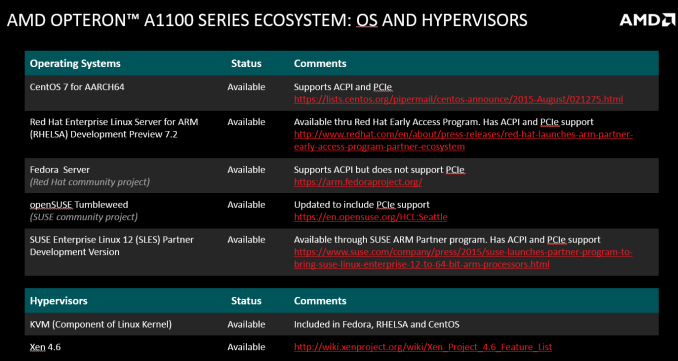The Silver Lining of the Late AMD Opteron A1100 Arrival
by Johan De Gelas on January 14, 2016 1:19 PM EST- Posted in
- Cloud Computing
- AMD
- Arm
- Opteron
- Opteron A1100
Feature Rich
But not all servers are compute limited. Quite a lot of server tasks are I/O limited. Think static webserving, reverse proxys (Varnish server), in memory key value stores (Memcached), all kind of network servers and "cold" storage servers.
| Low End Server SoCs: feature comparison | |||
| Feature | Opteron A1100 | Atom C2000 | Xeon-D |
| Max. RAM Capacity | 4 x 32 GB RDIMM | 4x 16 GB RDIMM | 4 x 32 GB RDIMM |
| PCIe | 8 gen 3.0 lanes | 16 gen 2.0 lanes | 24 gen 3.0 lanes 8 gen 2.0 lanes |
| SATA | 14x SATA3 | 2x SATA3 4xSATA2 |
6x SATA3 |
| Ethernet | Dual 10 Gb | Dual 1 Gb | Dual 10 Gb |
| USB | Not Integrated | 4x USB 2.0 | 4x USB 3.0 4x USB 2.0 |
With 14 SATA ports and two real 10 Gb Ethernet ports, AMD's A1100 is a great place to start to build a storage device. Considering that quite a few storage devices now use a quadcore A15, which is limited to 4 GB of RAM (16 GB with PAE tricks), an octal core A57 that can address 128 GB opens up new opportunities. The quad core A1120 will do nicely even though it might consume up to twice as much (25W) as Annapunra Labs Alpina AL5140 SoC (Quad A15 at 1.7 GHz), which needs around 10W. In a storage device with 16 disks, 10W should not be a deal breaker, especially if you can offer more caching, faster encryption and higher overall performance.
The specs do not look bad for a caching server either, as 32 GB RDIMMs are less expensive per GB than 8 GB RDIMMs now.
Software Support, or Why it Took So Long
The other big question is of course why A1100 took so long. The answer to that is actually pretty simple. Some of the building blocks like fine tuned ACPI and PCI Express support for ARM CPUs were not initially adapted to the server world, and AMD needed to wait for those to come along to give A1100 a fighting chance.
Just look at the slide with software support and see the comment "supports ACPI and PCIe". That would look pretty odd on an announcement of an x86 server CPU, but it is relatively new for a 64 bit ARM server environment. You might ask yourself how our Applied X-Gene server worked well with Ubuntu server nine months ago. The X-Gene server ran a specially adapted version of Ubuntu. That is fine as a temporary solution, but unless the modifications go "mainstream linux", each new version must be adapted again to make it work with your server. Costly and time consuming, so AMD went the other way, making sure that the necessary improvements were part of the official Linux kernel.
For the Ubuntu fans: the A1100 runs on top of ubuntu 15.10. According to AMD, it is fully functional but at the moment without support of Canonical.











37 Comments
View All Comments
silverblue - Friday, January 15, 2016 - link
Is an A1120 going to use 25W on average in all likelihood? Considering it's clocked the same as the A1150 which has a 32W TDP but double the cores, I doubt it.Torashin - Friday, January 15, 2016 - link
Whatever happened to their Freedom Fabric?zodiacfml - Friday, January 15, 2016 - link
It is late but they don't have a choice. Sell it without profit or at a loss then do better in the next generations.blzd - Friday, January 15, 2016 - link
With AMD's limited resources, was this really worth investing in?mctylr - Friday, January 15, 2016 - link
With AMD's limited resources and Intel's aggressive, and at times, illegal anti-competitive practices, AMD cannot compete with Intel on Intel's terms, so they need investigate how to success where Intel (and Nvidia) isn't dominate (i.e. where Intel / Nvidia isn't focused).AMD identified "micro servers" or "low power" servers as a potential market segment where it isn't obvious that Intel or other processor manufacturers will dominate this market.
History has repeatedly shown that new technology is almost always released in a fashion where it isn't polished, and in many cases actually new (different) technologies as opposed to a new generation of an existing technology, don't actually dominate over older technology within a single product development cycle, but it is still informative to follow progress to know what works or is promising, and what doesn't work.
nils_ - Wednesday, January 20, 2016 - link
That article needs some serious proofreading...BMNify - Thursday, January 21, 2016 - link
"Thanks to the Linaro "96boards enterprise edition", a 300-400$ SoC + board should be available soon and make it much cheaper to build software for the 64 bit ARM ecosystem.""the board will feature a 4-core AMD Opteron A1100 Series processor with two SO-DIMM memory slots, PCIe®, USB, SATA, and Gigabit Ethernet capabilities."
theres the AMD problem right there, the core SOC has 2x 10GbE and yet they will not release a cheapish 300-400$ board with the only real 10GbE option you are likely to buy gimped, sad as they could actually make a profit on these 10GbE SOC in the 2016 world consumer markets